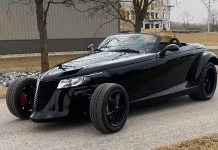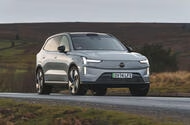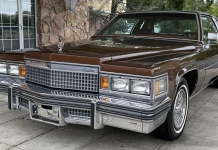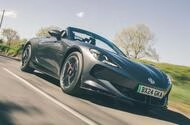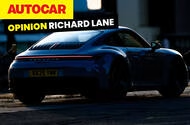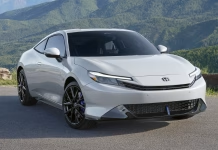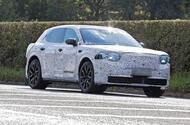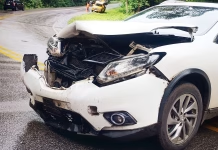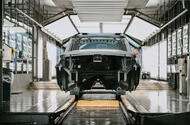Hellcat Prowler Manual Swap Turns Heads with Wild Performance
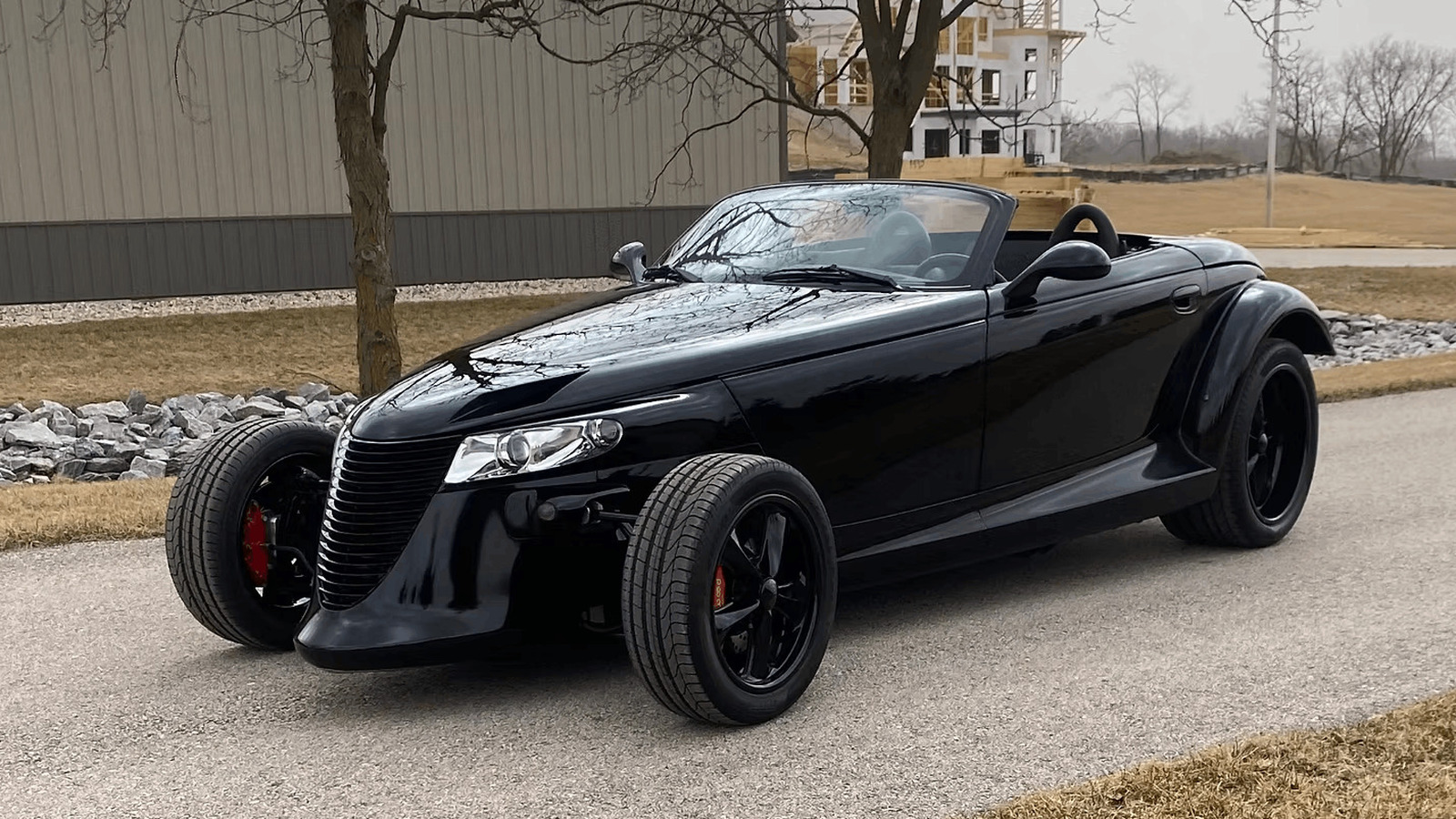
Volvo EX90 Gains Key Safety Upgrades and Faster Charging with 800V System
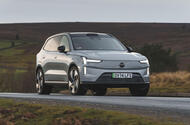 Hardware and software upgrades also bring 800V electrical system for MY26 examples of electric SUV
Hardware and software upgrades also bring 800V electrical system for MY26 examples of electric SUV
Volvo has given the EX90 major hardware and software upgrades, adding previously promised safety features to existing cars and boosting the electricals to 800V for 2026-model-year cars.
The software upgrade means the electric SUV gains an additional Nvidia Drive AGX Orin processor (in place of an older Nvidia Xavier chip) to run its 'brain', bringing it in line with the new ES90.
This boost in power to 500 TOPS (trillion operations per second) unlocks a host of additional safety features through the car’s lidar sensor.
This includes the ability to steer away from pedestrians and cyclists in the dark and come to a controlled stop if the driver falls ill. It also expands the car’s automatic parking ability.
While part of the MY26 update, the upgrade will also be available to existing EX90 owners via a free workshop upgrade, Volvo said.
It comes six months after the first EX90s were delivered to customers, sparking criticism that early adopters would need to wait for an upgrade before being able to use all promised safety features.
Speaking previously, engineering boss Anders Bell called it a “unique” situation where Volvo would be able to do the retrofit hardware update because relatively few cars would make it to market with that system.
Additionally, the new computing power unlocks the ability for bigger and more impactful over-the-air software updates. Volvo plans to launch four major software upgrades per year, alongside regular updates.
The MY26 EX90 also comes with the ES90’s 800V electrical system for its SPA2 platform – double the voltage in the current EX90.
This increases the battery's maximum rapid speed from 250kW to 350kW, meaning 155 miles of range can now be added in just 10 minutes.
The increase in speed is also achieved because the new system reduces heat generation during charging, enabling faster speeds.
What’s more, the new system is said be able to deliver faster acceleration, although Volvo hasn't disclosed a new 0-62mph time. The current car in range-topping Twin Motor Performance guise can achieve the feat in 4.9sec.
Volvo says the efficiency of the new system also means a smaller battery and motors can be fitted to the car, meaning less materials and a lighter weight.
No technical specifications for the MY26 EX90 have yet been disclosed. Pricing is expected to slightly rise on the £83,000 for the entry-level single-motor EX90.
Car Regrets Stories of the Ones That Got Away
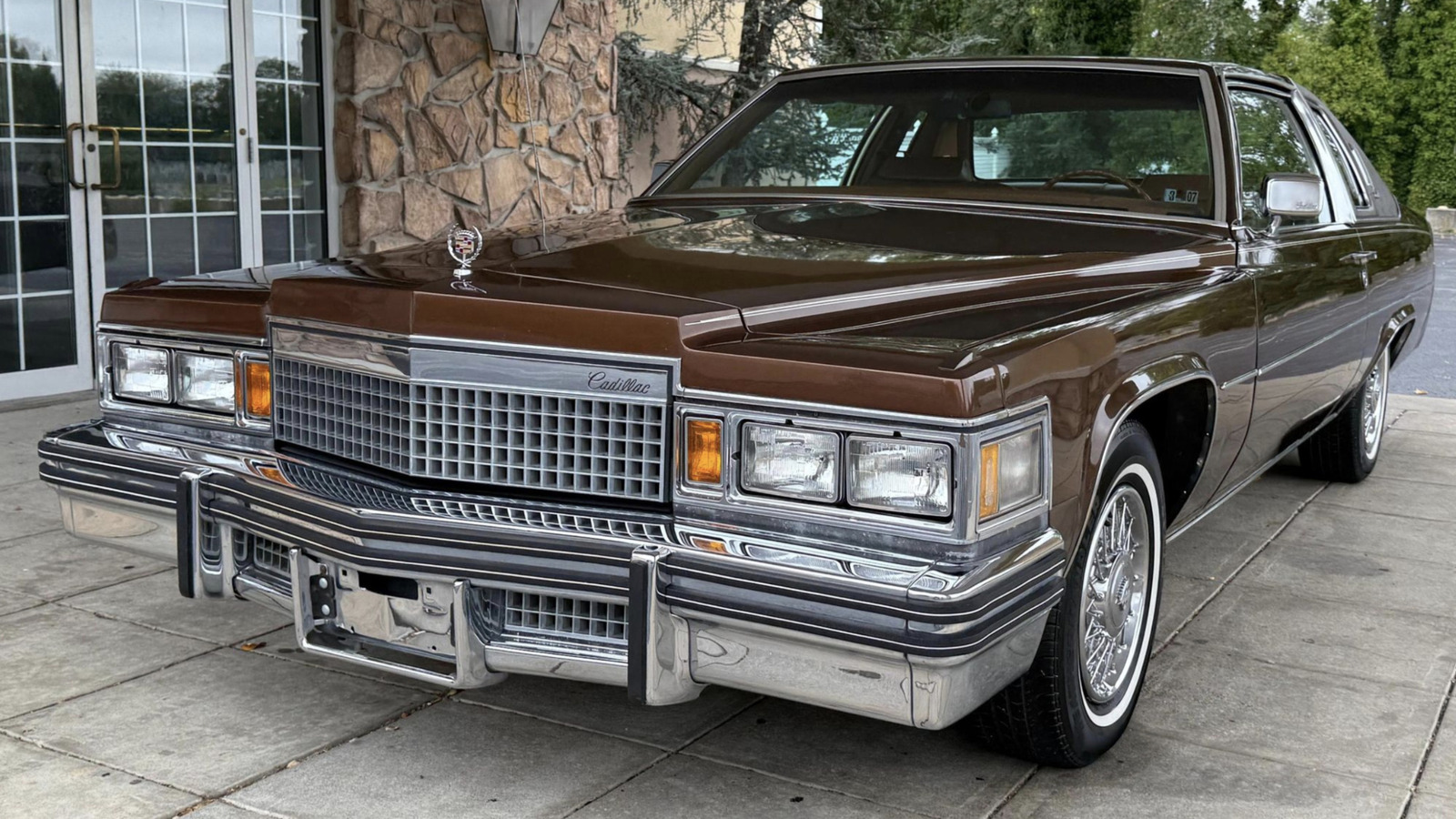
MG Cyberster Long Term Review Is This Bold Electric Roadster a True Game Changer
 Time’s up with our oddball electric roadster. Did it make its mark?
Time’s up with our oddball electric roadster. Did it make its mark?
Autocar is playing host to an MG Cyberster for the next few months, and I’m to be its custodian. This is a £60,000, battery-powered, two-seat roadster that goes from 0-62mph in 3.2sec and has electrically operating scissor doors.
How far back in time would we have to travel before it would seem daft that a Chinese manufacturer might attempt to make a car as exotic and glamorous as this? I might suggest not very.
I thought comedian Denis Leary said this, but the internet tells me it was PJ O’Rourke, who wrote in 2010: “There are 1.3 billion people in China, and they all want a Buick.” Well, now there are 1.4 billion Chinese, and they don’t all want a Buick; they want to make something better than a Buick.
In 2010, China was already making more cars than any other country in the world; now it’s three times as many as the world’s next most productive country, but more Chinese cars are domestic brands, not joint ventures with Western car makers. That stage is over.
MG is unusual here, because while it is now a domestic brand, owned by SAIC, the Chinese state-owned maker, it still plays on its British heritage, both here and there, and it retains design and engineering offices in the UK.
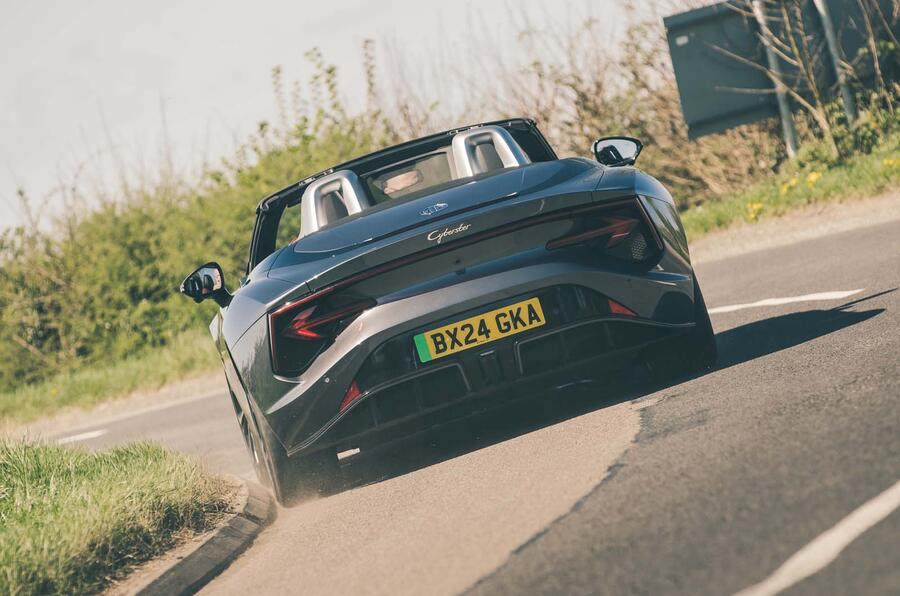
In China, where you can buy a dual-motor Cyberster for £40,000, they even use an MGB roadster alongside it in adverts. This dual-motor Cyberster, called the GT, sits at the top of a simple two-model range.
The base car, the Trophy, has a single rear motor and 335bhp to give it a 0-62mph time of 5.0sec. The GT, though, supplements that with a motor driving the front wheels too for a system total of 503bhp and that sparkling 0-62mph time.
It retails at £59,995 and, like the £54,995 single-motor version, comes with the works: if you’re looking for options, there’s metallic paint at £545 or £595 and a £500 red hood option alongside some paint colours (but not red or yellow, presumably on grounds of taste).
There are two interior colour options, grey or red, both at £0. This one is red, and it’s rather restrained. And that’s it. MG is not one to make you delve into an options list. There is one wheel choice (20in alloys with Pirelli P Zero tyres, 245/40 fronts, 275/35 rears), heated seats, heated steering wheel, electric seats, electric hood, electric doors, a Bose stereo, adaptive cruise control, vehicle-to-load capability and more ADAS than are mandatory.
I’ll expand on the ADAS another time, because the attention assist function is the worst performing of the lot and seemingly the only one that can’t be switched off.
Both variants of the Cyberster have a 74.4kWh (usable) battery capacity, and this GT a 3.2mpkWh combined-cycle rating with a 276-mile WLTP range. I’m seeing more like 250, but I’ll keep an eye on it.

Its maximum charge speed is 144kW, but so far I’ve charged it only at home. I’ll keep an eye on that, too. The MG will take some getting used to. There is an instrument binnacle, a screen either side of it controlled via steering wheel buttons and a central touchscreen, with functions spread throughout.
There are steering wheel paddles, the left for changing the retardation rate, the right for flicking through drive modes, which include a custom one: you can choose drivetrain and steering response.
In default Comfort mode the car only uses the rear motor, I think, given more leisurely acceleration and slight rear-wheel scrabble on driveway exit; sportier modes introduce the front motor and up the responses until they’re at pretty remarkable levels in Track mode.
The chassis does its best to keep up. This is a heavy car, particularly for a two-seater of, by today’s standards, reasonable proportions, being 4.54m long by 1.91m wide (2.1m including mirrors).
It’s 1985kg at the kerb (the single-motor variant is a full 100kg lighter), so the non-adjustable, passively damped suspension has the unenviable job of both keeping on top of body movements and retaining the kind of ride compliance MG would like the Cyberster to have.
MG does talk of “uncompromising power and performance”, but at the same time this version is called GT, and the company mentions giving “the grand touring experience”.
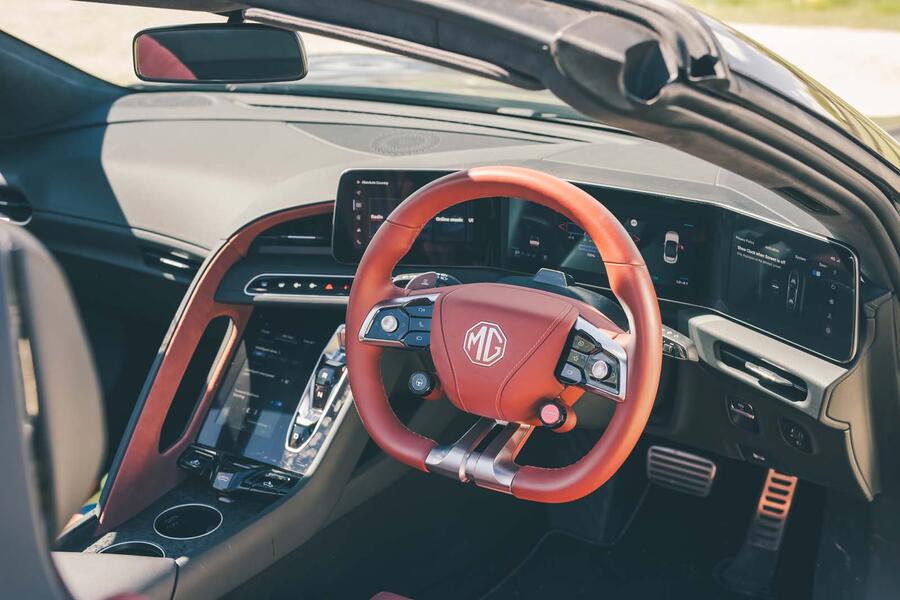
That’s a fine path to tread with relatively unsophisticated underpinnings. I haven’t tried a single-motor car, which the testers say is softer; I haven’t quite decided which way, if either, I’d want this to go. Big surface undulations generate some heave, but pitch and roll are well contained. The centre of gravity is low, after all.
That there are batteries beneath you means you don’t feel nestled deep into the interior, but neither do I feel like I sit precariously on top of it, like our taller testers did.
The fact that we have a car like this at all, though, and that MG is the first one to give it to us, shows how far the company has come and how fast. How quickly this car works its way into our affections, we’ll find out.
Update 2
I almost knew it would be a bad idea to leave the MG Cyberster unplugged in a car park for a week. We’ve received enough letters about (some) EVs and PHEVs conking out when left for extended periods that I nearly took an old diesel to the airport instead. But don’t be so silly, I told myself – it’ll be fine. And if it’s not, that’s the point of trying it.
It wasn’t fine. On my return I pressed the key fob and, sure enough, nothing happened. Not a peep of sound, not a flash of lights nor the merest hint that the car knew I was standing next to it, apoplectic, trying to unlock it.
I pressed the button again, and again, then all the other buttons on both car and remote, repeatedly and exhaustively – sometimes simultaneously – even though I knew it wouldn’t make a difference. The car had enough electrical power in it to drive to Nottingham, but not enough to open the doors.
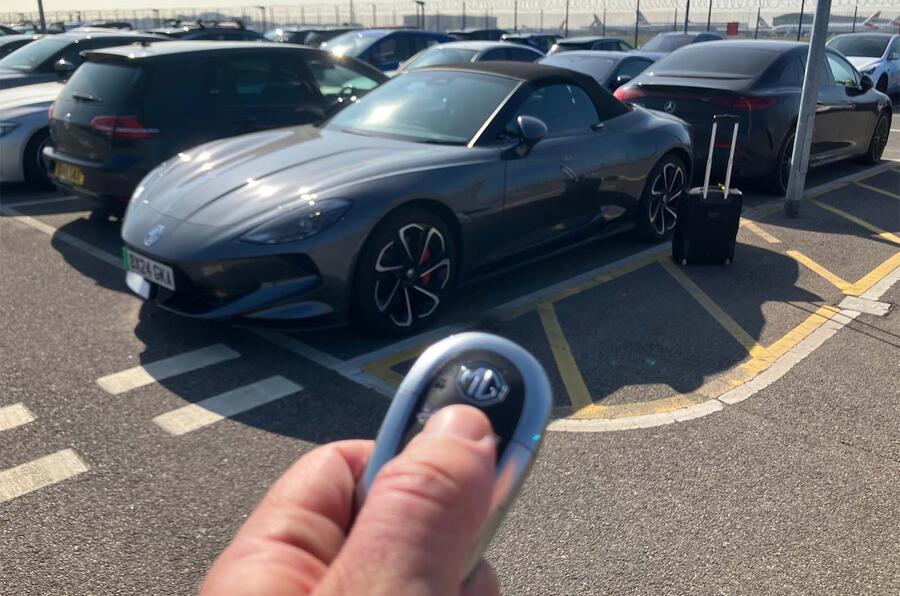
This is apparently a thing with some EVs. They have a very large high-voltage drive battery but, like all cars, also a 12V system that runs everything else.
If the 12V battery on an ICE car is low, it will at least have a go at spinning the engine into life so it can charge from the alternator. If the 12V battery on an EV is low, it won’t dare try to connect the big switch to the high-voltage system.
Some EVs will keep an eye on themselves and periodically connect to the high-voltage system to top up the 12V battery. Others, apparently like the MG, do not.
I needed access to the 12V battery. Some cars have a physical key within the remote so you can at least open a door. The Cyberster doesn’t. Its door and boot buttons are electrically operated, so in the event of a flat 12V you can’t get into the cabin. And as well as being where you left your house keys, that’s where you’ll find the bonnet release to access the 12V battery.
Mercifully, MG’s techs have a workaround: behind one of the front bumper’s towing eye access panels is a wire pull that unlatches the bonnet, so you can get under there, if not to your house keys.
With bonnet up and terminals located, I phoned the car park operator who kindly sent a man in a van with a 12V jump pack, but it wasn’t quite good enough to coax the Cyberster into life.
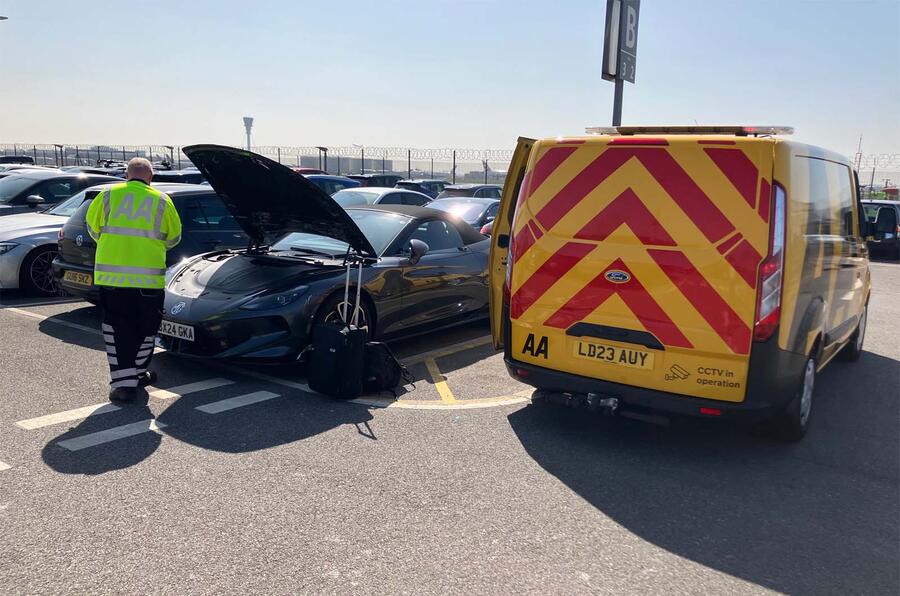
So I called the AA, and after a short wait a very, very nice man called Simon (who remembers the old ‘very very nice man’ AA ads but was too polite to say he’s tired of hearing about them) arrived with an ammeter and a fully juiced jump pack.
Diagnosed and with the pack connected, the MG sparked into life, opened its door on command, quickly threw up about three dozen error messages and then got over itself and behaved normally.
Simon has come across this problem before but hadn’t seen the secret bonnet release, a tip that, via the AA grapevine, will now be more widely known. And thanks to Heathrow’s car park, which quickly sent help and confirmed there would be no charge for overstaying, or for the AA.
The car has been fine since, but I know one long-haul pilot who has cancelled a Cyberster order as a result of the tale.
Update 3
As I write, it’s quite warm and dry out so I’ve been popping the roof down on the Cyberster as often as not. This doesn’t take long, and can be done at up to 28mph, which means if it gets too toasty for my wee baldy heid, I can put it back up again without much bother.
I’ve had a letter or two about the driving position, because the MG’s is relatively high in the roadster scheme of things: the battery is underneath the floor, so you can feel like you’re sitting more on than in the car.
Mind you, the MGF had a similar issue and this car does say ‘100th anniversary’ on the side. I’m not sure it’s a deliberate intention to continue that part of the MG heritage, but still. It feels on-brand.
I don’t find the driving position such a bother as one reader, shorter than I am, who simply couldn’t put up with it. I’m 5ft 10in and my head isn’t into the headlining with the roof up, and I’m looking cleanly underneath the screen’s header rail with it down. Maybe I have the seat more reclined?
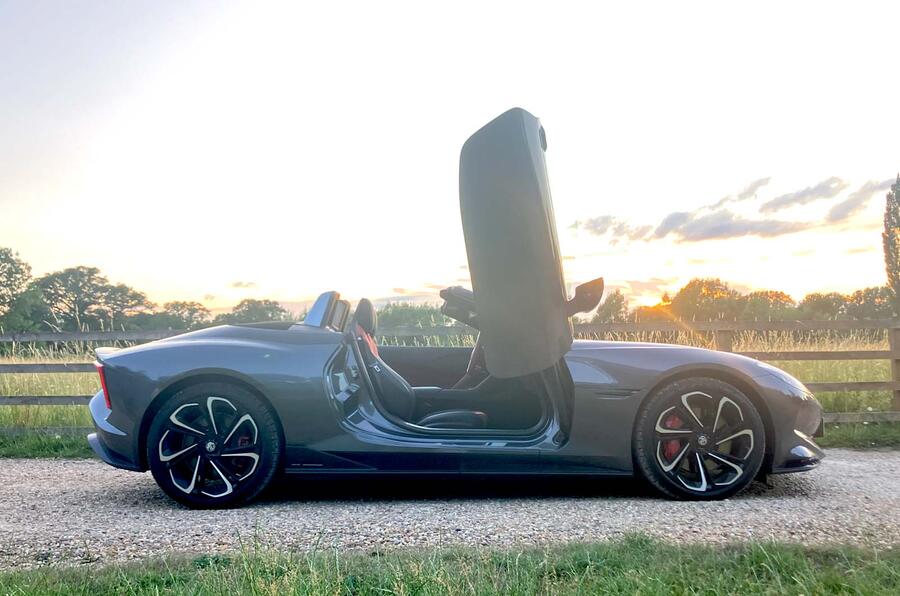
It’s something worth considering if you’re thinking about a Cyberster, though, particularly if you are tall, because as in, say, a Jaguar F-Type, the seat doesn’t slide so far back, and the further back you go the less reclined you can have it.
Anyway, what this means for me is that, roof down, the wind isn’t too much in what was once hair. I get that pleasing open-air feeling, the ability in traffic to look up at passing aeroplanes or red kites, without too much buffeting.
There’s a wind deflector and I’ve been leaving it in place because it’s not hard to look through it via the interior mirror. It’s like looking through a fine fly screen or something like that.
It sits between the two roll bars and can easily be pulled free, or relocated, with one hand. So if it bothers you, it’s a doddle to get it out of the way. It’s even marked ‘front’ on, er, the front, so you know which way around it goes when it comes to putting it back quickly.
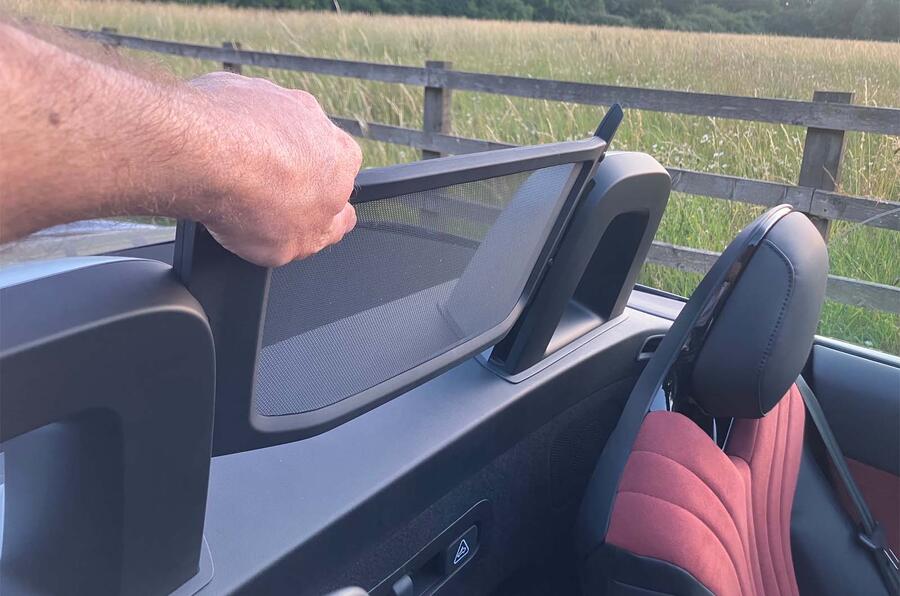
I wouldn’t recommend trying to put it back in place on the move, but you can easily pull it free while driving, although with roof down I’m not sure you’d want to.
Having it in place doesn’t make too much difference to the amount of buffeting around your head, but it does seem to reduce the amount of turbulence swirling around in the middle of the cabin, curiously. Without it in, I’d want to secure any valuable receipts. Keeping the side windows up also considerably reduces turbulence, so unless
I’m mooching around town, I tend to keep those up too. The easiest stowage for the deflector is probably in the netted cargo area behind the seats.
It’s where the emergency manual handles for the otherwise-electric door releases are too. You couldn’t fit a set of golf clubs back there, but for oddments stowage it’s a handy ‘accessible, but not in the cabin’ space for things you might normally put in the door pockets.
It does have those too. It’s just that they’re small and they snap shut, because the doors raise through 90deg and it would throw my sunscreen and window cleaner onto the floor if they had conventional door pockets. Actually, for a two-seat roadster overall, luggage volume is pretty good.
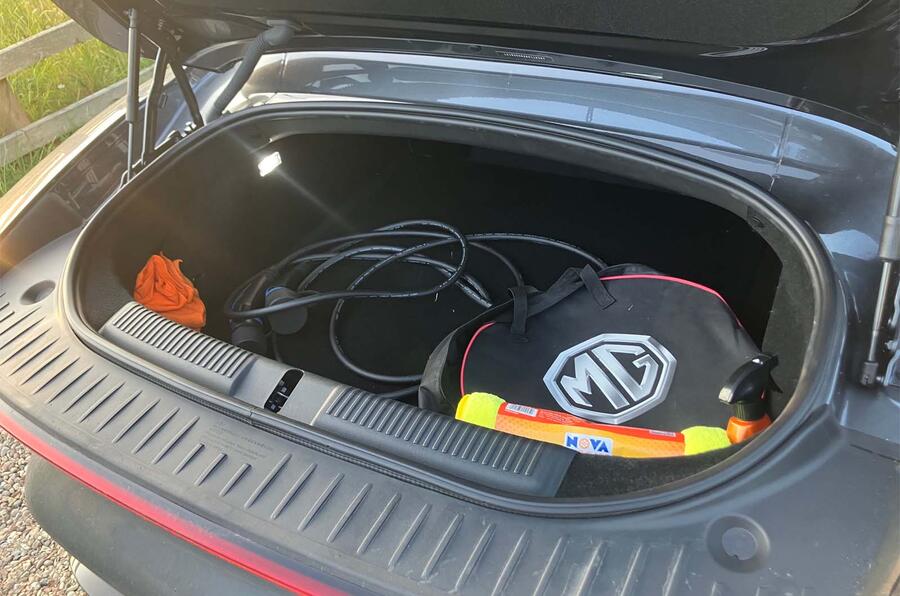
The boot, if not deep, is quite long, and while all you’ll find under the bonnet is a vast black plastic shield with compartments for fluids and battery, it’s not like anything with an engine has space there either.
Having the roof down, or the audio up loud, also means there’s more ambient noise kicking around so you can’t hear some of the MG’s more irritating chimes and bongs.
I’ll expand on those another time because I think they deserve a report of their own.
Update 4
As I briefly caught sight of the rear of a metallic grey roadster while viewing a page on the internet, I wondered why ‘my’ MG Cyberster was being photographed and written about.
My mistake: it was a picture of the rear of the new Aston Martin Vanquish Volante. On anything more than a glancing cursory inspection, the two of course don’t look like each other, but in a week when MG has also launched a 742bhp super-saloon, I do get a sense that the old rules about who makes quick and expensive and glamorous cars and who does not are presently being rewritten.
I recently took the Cyberster along to a photo and video shoot in Wales to meet a different Aston Martin, a Vantage Roadster, plus a McLaren Artura and a Ferrari Roma. The MG wasn’t part of the test: these are luxury sports cars with mighty engines. But if you take a look at the picture above, does it look so out of place?
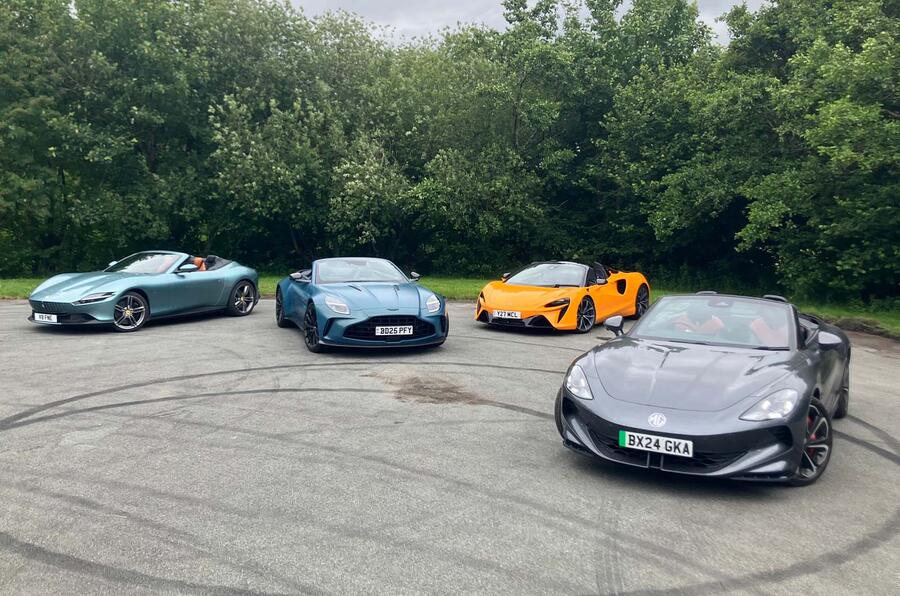
Well, it is a bit out of place, ultimately. Look closer and you will see a sensor on the electrically opening door, supposedly subtle, but, like a shell hole amidships, it’s very noticeable and often one of the first things people talk about when they look at the car.
The headlights, too, instead of being some multiple-billion LED set-up, are relatively conventional, but then they are backed with some etching so they look more technically complex than they are.
And on the boot sill there’s a note that seemingly hasn’t been beyond one round of Google Translate: ‘NOTICE! Please do not place heavy objects and don’t seat,in order to avoid damage to vehicle parts.” Bad English aside (missing space after the comma included), isn’t it odd that you can’t sit on a boot lip?
None of these things is overtly annoying, though, unlike my biggest beef with the Cyberster: its driver attention monitor. Unlike all of its other GRS2 safety-regulation-mandated ADAS components, this is one that can’t be switched off, and yet it’s the one that works the worst.
The theory – and damn whoever made this mandatory – is that a camera on top of the steering column monitors your eyes and tells you if you’re not paying attention to the road, via a chime and a dashboard notice.
The rulebook says for how long you can look away before the warning appears. The trouble is that here it works appallingly. Perhaps it’s because I’m wearing glasses, but I suspect not.
Glance at the temperature switches to increase fan speed? Ding! ‘Please focus on driving.’ Driving down a slip road looking in the mirror? Ding! ‘Please focus on driving.’ Just viewing a mirror to plan a motorway overtake? Ding! ‘Please focus on driving.’ Looking at length into the driver’s footwell in search of a lost jelly baby? Nothing.
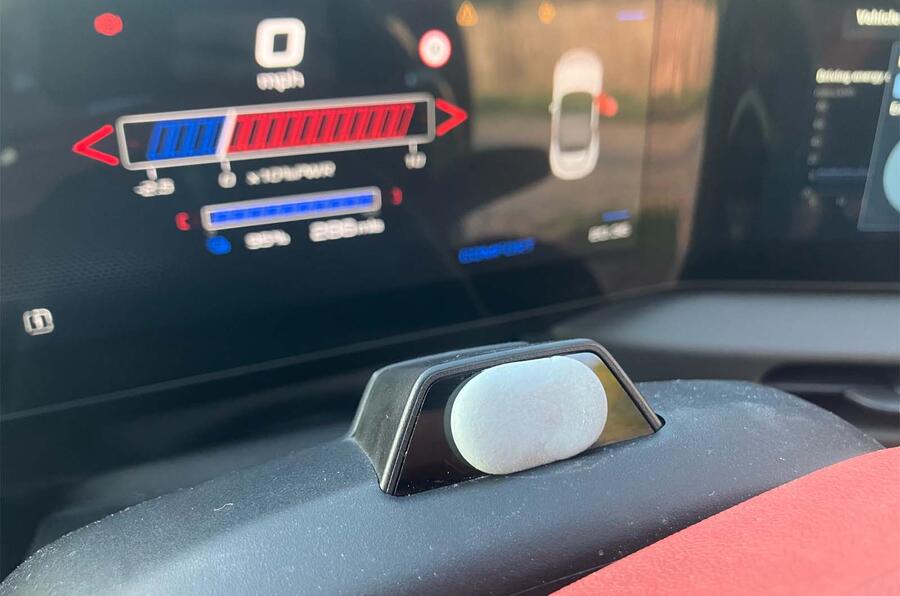
Worse, even if dinged into submission, so staring resolutely straight ahead and ignoring the safer option of checking your surroundings, the heckling chimes can continue for some time afterwards. It’s truly awful.
The saving grace is that if the audio is loud or the roof down you probably don’t hear it, at least not if it’s just a single chime. And that’s what I’ve reduced the system to, after trialling a few other options, including sticking a passport photo of myself to the steering wheel boss. It seemed to work briefly, but in a constant-radius bend the car thought I was falling out of my seat.
The answer, then, came in the high-tech form of a piece of Blu Tack over the camera. Now every time I slow down the car gives a single ding and says the camera is blocked, but it’s only a single ding. Around town, where the system is slightly less erroneously insistent, I sometimes remove it.
As a result, I’m experiencing something of a like-loathe relationship with the Cyberster. That it’s fitted with this system isn’t MG’s fault, but that it works this badly and can’t be switched off is.
Final report
It’s normal for a new car to generate a certain level of interest, but I have never run a car that has prompted such divisive reaction as the MG Cyberster.
I’ve had correspondents say they absolutely love theirs and that it’s much better than the combustion-engined European convertibles it replaced; others say they sold or returned theirs after not getting on with it at all.
I’ve had a shorter driver say he felt seated too high to buy one but a taller one think it was fine, while one reader (presumably not an owner) even told me to “eat shit” at 1am on a Sunday because we acknowledged MG’s success at our awards. Swings and roundabouts, I suppose.
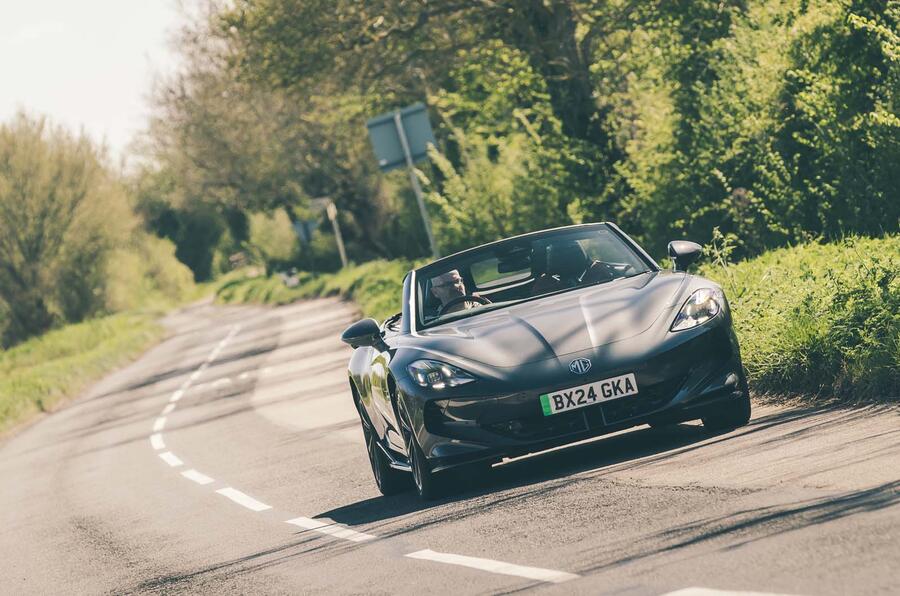
After spending 3000 miles over a few months in the Cyberster, I’m still slightly conflicted about my own thoughts on it. I like the fact that any manufacturer, let alone a mainstream one, has come up with a fast electric roadster that looks as good and drives as convincingly as this.
But it has foibles that I couldn’t live with if it were my own car, and I don’t think it’s a particularly good idea for us all to buy cars from Chinese state-owned car makers if we value having European ones – although why this seemingly bothers us so much about cars while it doesn’t in other industries is a discussion for another place.
So to the details. The Cyberster arrived with us in its range-topping GT form. The single-motor base version is called the Trophy, while this twin-motor top car is the GT, which cost £59,995 at the time of arrival but is £60,245 now.
Mechanically, it’s a relatively straightforward proposition. The Trophy gets only a 335bhp rear motor, while the GT adds a front motor for a system total of 496bhp and a 0-62mph time of 3.2sec.
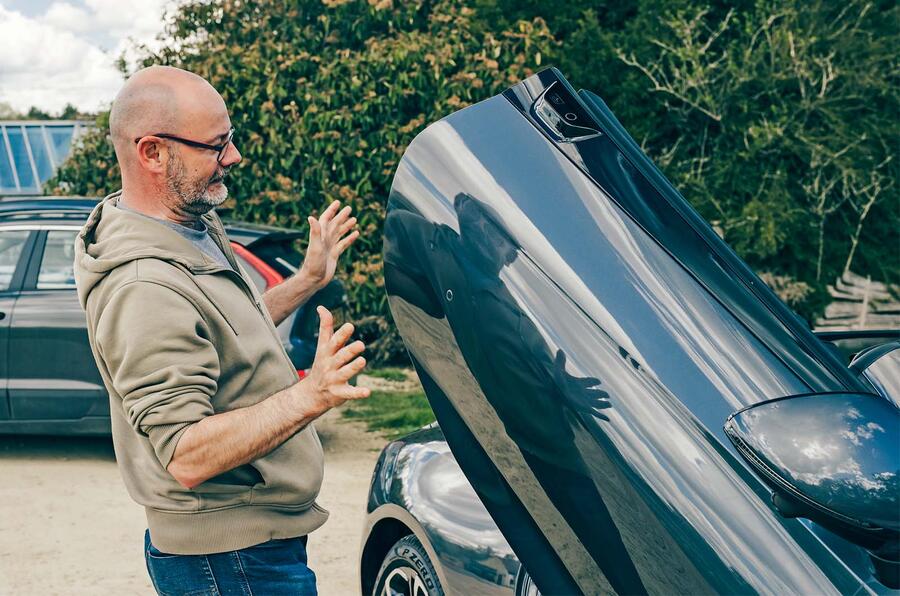
It has, like the Trophy, a 74.4kWh usable battery capacity. It also has a combined cycle rating of 3.2mpkWh and a range of 276 miles, which in warmer weather and moderate driving I’ve found the Cyberster can better and in cooler weather and faster driving it will not.
Overall I matched the WLTP figure, because I ran the car over summer and used it for a lot of pootling about. Over a longer period I might not have. It comes with a lot of kit and not very many options. There are only two interior colour options, grey or red, both £0, plus one wheel choice, metallic paint and a red hood option.
The only option on this car is the £545 metallic paint. It has heated seats and steering wheel, electric hood, electric doors, a Bose stereo, adaptive cruise control, vehicle-to-load capability and more.
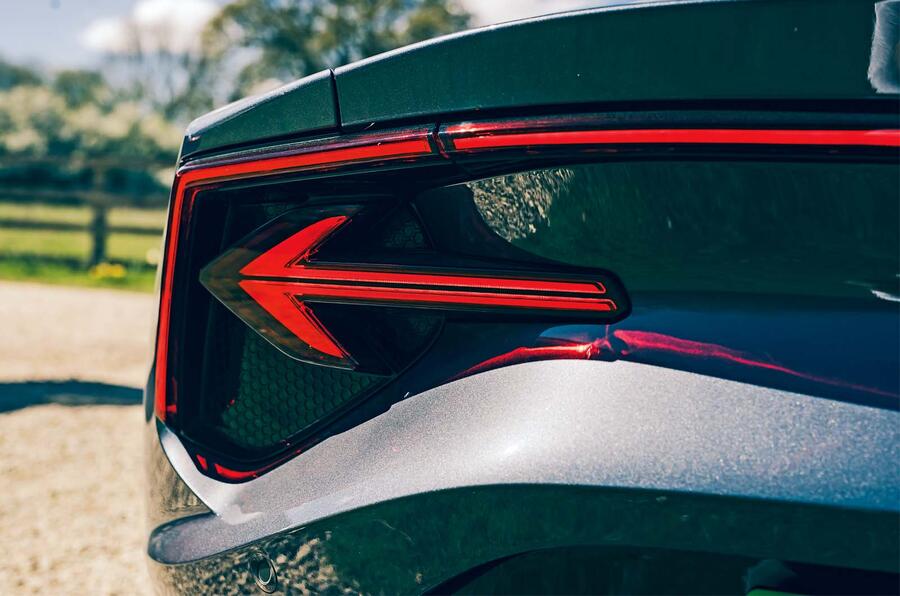
They don’t make you take out a subscription for additional power or heated seats or any of the assistance systems. The practice is back in the news from European car makers, and it’s ghastly and customers hate it, so is it any wonder that people will buy an MG instead? This car comes kitted out and that’s that.
I would, however, have preferred manual doors to the electric ones, because they would be quicker, they wouldn’t have unsightly sensors on the side and, when I left the car for a week in a car park and the 12V battery went flat, I could have had a physical key to at least gain access to the cabin.
If the car is immobile, you have to reach the 12V battery terminals by popping the bonnet via a cable behind the bumper. Some EVs and PHEVs allow their 12V systems to hook up to the high-voltage battery (which in my case still had about 70% charge) to keep themselves topped up, but this MG doesn’t.
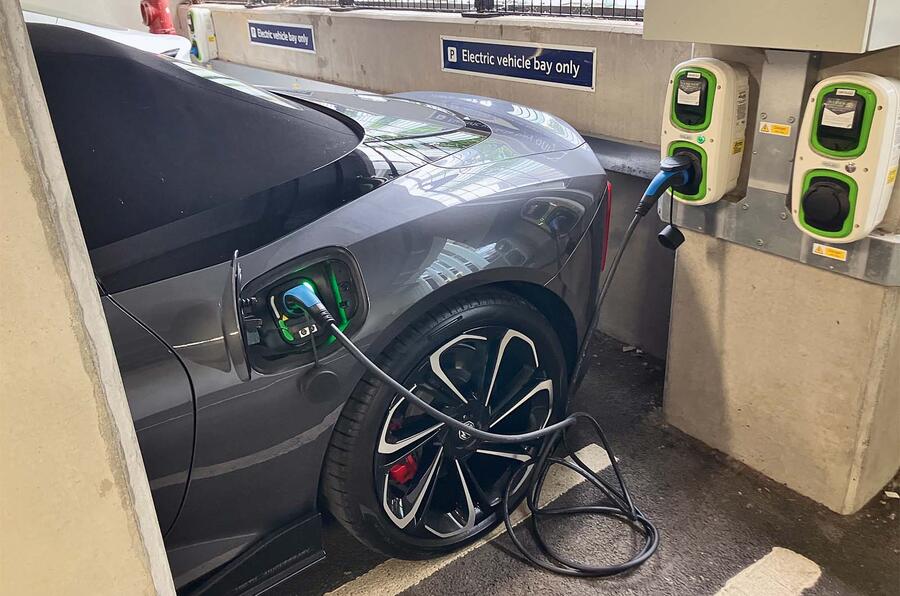
I know one reader, a pilot who often leaves his car at airports, who cancelled an order as a result. Some of the Cyberster’s mandatory equipment is irritating too. It’s not MG’s fault that it has an ADAS suite, but it is to blame for the fact that the driver attention monitor bongs that I’m not paying attention when I very much am and that you can’t switch that system off.
An owner, though, says he hasn’t seen a similar message in 10 months of owning his car. Could be it’s my glasses, but making the system switchable would solve the issue.
Those things are very annoying (the bongs mean I couldn’t live with the car) but they are the Cyberster’s only genuine foibles. I found the seat had too much lumbar support but otherwise got on fine with the driving position.
With the audio up or the roof down the chimes of doom are harder to hear, and at those times I found the car easy to like. It has smooth steering, a relaxed if too-loose ride on undulating roads and, in its sportier drive modes, really urgent pace.
The short of it is that while we’ve lived with one, I think you still really need to try one yourself. You might love it, you might hate it or, like me, you might swing between the two.
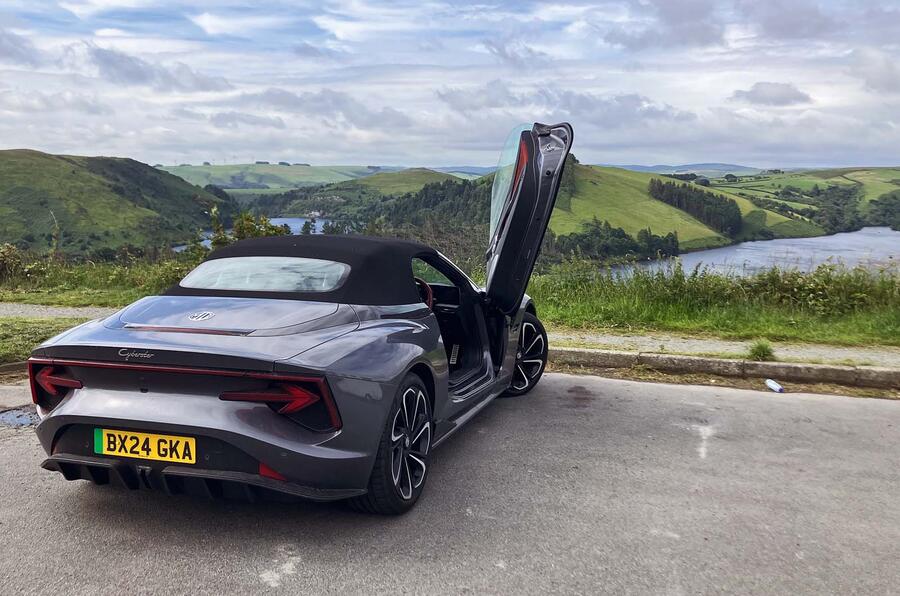
MG Cyberster GT specification
Prices: List price new £59,995 List price now £60,245 Price as tested £60,540
Options: Camden Grey Metallic Paint, £545
Fuel consumption and range: Claimed range 276 miles Battery size 74.4kWh Test average 3.2mpkWh Test best 3.7mpkWh Test worst 3.1mpkWh Real-world range 240 miles
Tech highlights: 0-62mph 3.2sec Top speed 125mph Engine Two permanent magnet synchronous motors Max power 496bhp Max torque 535 lb ft Transmission 1-spd reduction gear, AWD Boot capacity 249 litres Wheels 8.5Jx20in (front), 9.5Jx20in (rear), alloy Tyres 245/40 R20 (front), 275/35 R20 (rear), Pirelli P Zero Kerb weight 2210kg
Service and running costs: Contract hire rate £850psm CO2 0g/km Service costs None Other costs None Fuel costs £278 Running costs inc fuel £278 Cost per mile 9pence Faults Flat 12V battery
Boeing vs Airbus Cockpit Controls Why Pilots Need Retraining

Porsche 911 Dominates as Rivals Disappear from the Sports Car Scene
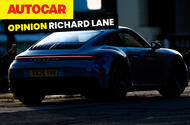 Some of you are sick of seeing the Porsche 911 in your feed
Some of you are sick of seeing the Porsche 911 in your feed
Fair warning: the next 750 words are going to be about the Porsche 911. Some of the readership thinks we cover this car too liberally, and they’re right, if for the wrong reasons. Why that is will soon become clear, but now’s your chance to click away and pretend none of this happened.
Still here? Much obliged. I’ve got 911s on the brain more than usual. It must be a result of a rear-engined diary concertina. In the past few weeks, I’ve driven RML’s Turbo S-based P39 prototype; I’ve been in Weissach to preview the new hybrid ‘dot-two’ Turbo S and have my innards torn up during a passenger ride; and I’ve done 1600 or so miles in the updated Carrera S.
The highlight of this triple-header is hard to call. The RML is a carbon fibre-bodied tip of the hat to the street-legal 911 GT1 Strassenversion, only with 50% more power and a literal tonne of downforce, plus road manners to match a factory-standard 911. It’s the answer to a question few are asking, but it is quite cool. Equally, sitting beside Jörg Bergmeister again as he peeled a Turbo S development car into a filthy great slide at 115mph – while asking how my day was going – was also cool. Actually, it was absurd. The same ride-along gave a colleague from another well-known mag the shakes, and he races stuff.
Then there was the Carrera S. Hardly the most memorable of cars, yet in the space of a few days it was able to serve up tail-out thrills on a West Country B-road, nail an indicated 202mph on an autobahn and crack through a 10-hour stint in Burmester-fed comfort with no small feeling of specialness. Yet it was not so conspicuously special that I got jittery leaving it in possibly Mannheim’s dingiest car park. If you want not just a sports car but an accomplice, here it is.
We write a lot about the 911 not because we are in Zuffenhausen’s pocket. Those pockets are emptier than usual, in any case. It’s because the 911 is an extremely good car. Not only this, but there’s also the depressing dearth of opposition to challenge it, which is a recent development.
This was a topic that I mulled often during those many miles in the new Carrera S. The competition: where the hell has it all gone? Not that long ago, the Carrera S, a showroom powerhouse derivative that generally accounts for about a third of all 911 sales, could be tightly cross-shopped with a great many cars: the Jaguar F-Type, Nissan GT-R, Lotus Evora, Mercedes-AMG GT, Aston Martin V8 Vantage, Audi R8 and Maserati Granturismo. Even Lexus was involved with the sensuous LC 500.
Now the Jag, Nissan, Lexus and Audi are all gone. The V8 AMG comes only with unnecessary 4WD. The pricing of the Aston and Maserati has gone to the moon. Unlike the Evora, the Emira has no rear seats and poor storage, and it’s on thin ice anyway. AMG is cooking up a CLE with a V8, but if it weighs less than a bull elephant, I’ll be amazed. The Corvette? Cracking car, and now made in RHD, but it’s just too flashy, isn’t it?
So we look to the BMW M4 CS. It’s a stunning machine: rapid, usable, and costs what the Porsche does. But is it not concerning that the closest rival to the Carrera S in terms of the crucial all-round package is an esoteric, extra-fruity M coupé that has no cupholders and isn’t exactly grown up? Improbably, Lexus may yet be our champion: it’s developing a V8 coupé to homologate a GT3 race car. This is the sort of activity we condone.
For now, the Carrera S feels like the last man standing. It has won the day; seen rivals eaten up and spat out – or simply transformed for the worse – by the economics of sports car making. It sounds like a dream scenario for Porsche, but it isn’t. Engineers love competition: they use it to improve their product and it prompts them to embrace their own engineering idiosyncrasies. Limited rivalry isn’t healthy for the 911, and the shelves of the affordable-ish, driver-focused 2+2 market being so shoddily bare is no fun for anyone.
We road testers particularly dislike a monoculture: it means smaller group tests, less variety, and assessments of steering feel, handling balance and the like begin to exist in a vacuum without points of reference from other companies who do things differently; sometimes ‘better’, sometimes ‘worse’. As simple creatures, we want hierarchy and context, dammit. So Porsche, keep doing what you’re doing. Make the Carrera S and co a bit lighter while you’re at it.
Everybody else, pull your bloody fingers out and give us something else similarly excellent – or we’ll have to prattle on about 911s.
Hybrid coupes on sale now include the new Honda Prelude as the most affordable...
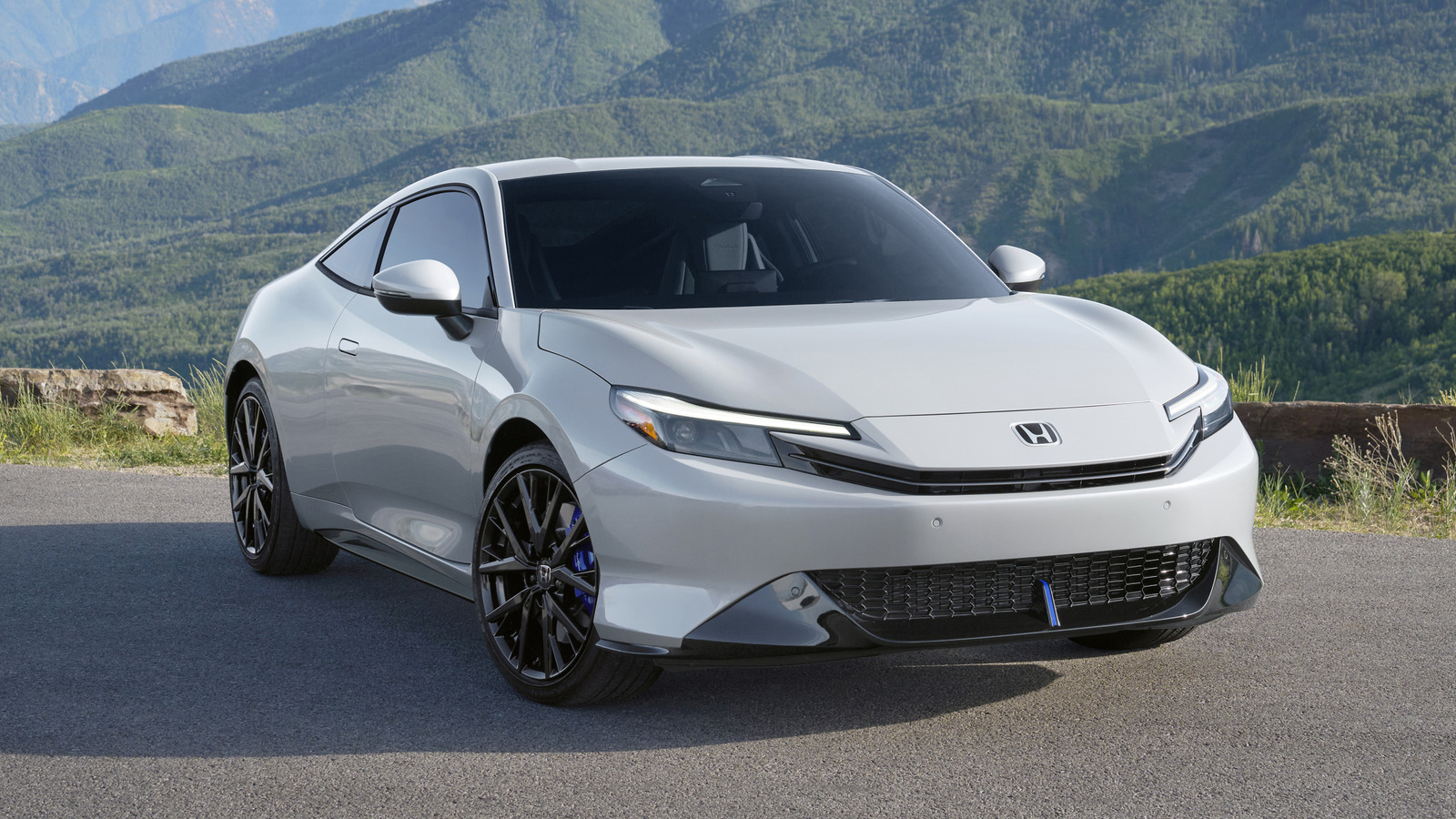
Bentley Electric SUV Debuts as Luxury Urban Model with 2027 Launch Target
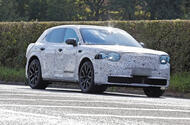 Crewe's first electric car will slot in beneath the Bentayga with styling influenced by EXP 15 concept
Crewe's first electric car will slot in beneath the Bentayga with styling influenced by EXP 15 concept
Bentley's first electric car has broken cover, as test prototypes hit public roads in preparation for an unveiling next year.
Pitched as "the world's first true luxury urban SUV", the unnamed new model will be the shortest Bentley yet, at less than five metres long, and will slot in underneath the Bentayga. It is due to be revealed in the middle of 2026, ahead of customer deliveries getting under way in the second quarter of 2027.
These new images show the SUV's production bodywork for the first time, demonstrating the influence of Bentley's new brand-shaping EXP 15 concept in its monolithic surfacing, bluff proportions and relatively low-slung silhouette.
Bentley hasn't yet confirmed any technical details of the new concept, but it will be based on a version of the Porsche-and-Audi-developed PPE EV platform and as such is expected to be closely related to the Porsche Cayenne Electric.
The new Cayenne is offered exclusively with dual-motor, four-wheel-drive powertrains putting out between 400bhp in the base car and 805bhp in the top-rung variant (rising to nearly 1000bhp with launch control). A 108kWh battery is estimated to supply a range of up to 373 miles in the most efficient variant and can be charged at up to 400kW.
There has been no confirmation of how closely related the two cars will be, but at just under 5.0m long, the Cayenne Electric is expected to be almost exactly the same size as the electric Bentley, suggesting scope for close collaboration.
The 'urban SUV' has been spotted the day after Bentley CEO Frank-Steffen Walliser told Autocar that a substantial reorganisation of sibling brand Porsche's EV plans will have an impact at Crewe as well.
Walliser said Bentley still plans to launch a new plug-in hybrid or fully electric car every year from 2026, beginning with the urban SUV, but will pursue a balanced powertrain mix to cater to slow premium EV demand over the coming years.
“There is a dip in demand for luxury electric vehicles, and customer demand is not yet strong enough to support an all-electric strategy. The luxury market is a lot different today than when we announced [our] Beyond100 [plan]," he said.
"Electrification is still our goal, but we need to take our customers with us."
The move is likely to mean the current Bentayga, Continental GT and Flying Spur will once again offer pure-petrol powertrain options in certain markets, having been planned to go PHEV-only.
Car Titles Explained Rebuilt vs Salvage and What Each Means for Buyers
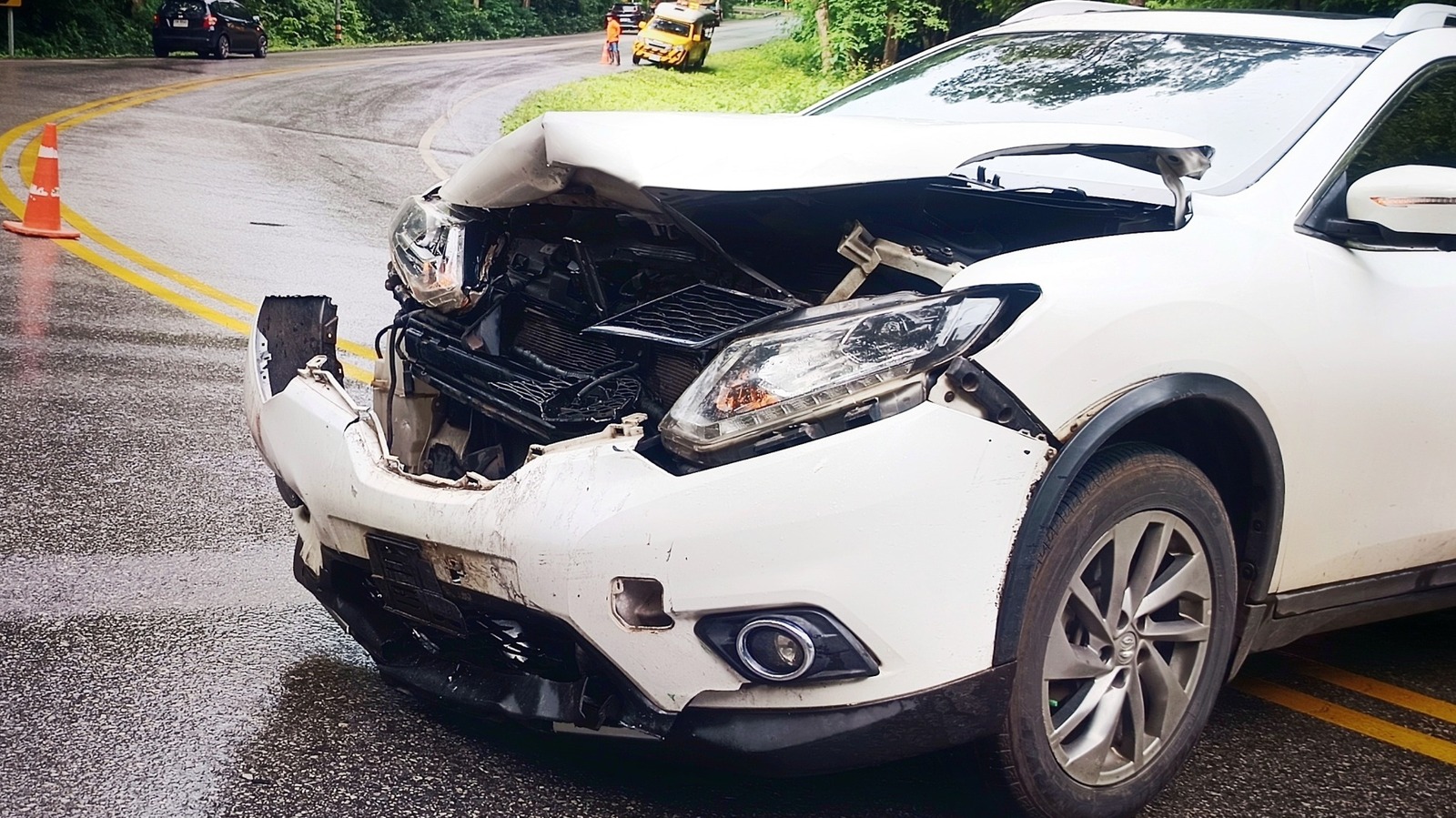
JLR cyber attack halts car production for a month as suppliers face crisis
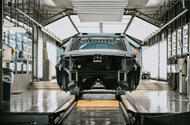 Company pushes back production restart by another week, extending pause to a whole month
Company pushes back production restart by another week, extending pause to a whole month
JLR has extended its vehicle production pause by another week, as it continues to grapple with the impact of a cyber attack earlier this month, and now plans to start building cars again on 1 October.
The company had planned to restart production at its UK and Slovakia factories tomorrow (24 September) but has delayed the restart as part of a plan to resume operations "in a safe and secure manner".
The move means the company will lose a full month of vehicle production, having not produced any vehicles since shutting down all its global systems in response to the attack on 1 September. The impact on volumes will be made clear when the company releases its production numbers for the quarter, but in the three months to September last year, JLR produced more than 80,000 Land Rover and Range Rover cars.
In a statement sent to Autocar, a JLR spokesperson said: "Today we have informed colleagues, suppliers and partners that we have extended the current pause in production until Wednesday 1 October 2025, following the cyber incident.
"We have made this decision to give clarity for the coming week as we build the timeline for the phased restart of our operations and continue our investigation.
"Our teams continue to work around the clock alongside cybersecurity specialists, the NCSC and law enforcement to ensure we restart in a safe and secure manner.
"Our focus remains on supporting our customers, suppliers, colleagues, and our retailers who remain open. We fully recognise this is a difficult time for all connected with JLR and we thank everyone for their continued support and patience."
The delay comes after the UK government stepped in to help the car maker resume operations following the incident.
A statement from UK trade body the Society of Motor Manufacturers and Traders (SMMT) last week confirmed the government was helping the effort, as JLR continues to rebuild the internal computer systems that were infiltrated.
As well as aiding moves to restart production, government cyber experts were helping to assess “any impacts on the supply chain”, which workers’ union Unite claimed on Wednesday was at the brink of collapsing.
The SMMT statement said: "The recent cyber incident is having a significant impact on Jaguar Land Rover (JLR) and on the wider automotive supply chain.
"The government, including government cyber experts, are in contact with the company to support the task of restoring production operations, and are working closely with JLR to understand any impacts on the supply chain.”
JLR added in its own statement: "This is an important move to further identify the challenges businesses are facing following the recent cyber incident at JLR."
The attack on 1 September has left JLR incapacitated. It has led to production shutdowns at all of JLR's global plants, created issues with parts ordering and stifled retailers.
The effect could be costing JLR up to £5 million a day, business economics professor David Bailey told Autocar last week.
Since the cyber attack, the majority of JLR’s employees have been off work, with lost hours being banked.
Union Unite said on Wednesday that employees within the supply chain are being told to apply for Universal Credit as they are moved onto reduced or zero-hours contracts by employers battling to stay afloat.
Earlier reports suggested that some suppliers “will go bust” as a result of the ongoing issues at JLR.
Unite general secretary Sharon Graham said the union has written to the UK government demanding it set up a furlough scheme to take the pressure off suppliers by supplementing workers’ pay packets while they’re unable to do their jobs.
“Workers in the JLR supply chain must not be made to pay the price for the cyber attack,” said Graham. “It is the government’s responsibility to protect jobs and industries that are a vital part of the economy.”
Graham cited a similar scheme set up on 15 September by the Scottish government to support bus maker Alexander Dennis and said “a similar scheme for workers in the JLR supply chain [should be set up] now”.
JLR suppliers 'could go bankrupt'
Recent reports have claimed that some of the firm's suppliers could go bust as a result of the shutdowns.
Former Aston Martin CEO Andy Palmer told the BBC on 12 September: “I would not be at all surprised to see bankruptcies.”
Palmer added that many suppliers will soon begin to slim their staff count as a result of the shutdown, saying: “You hold back in the first week or so of a shutdown; you bear those losses. But then you go into the second week, more information becomes available – then you cut hard. So layoffs are either already happening or are being planned."
Along with Unite, another making the call for a furlough scheme is Commons Business and Trade Committee chairman Liam Byrne.
The Labour MP said: "What began in some online systems is now rippling through the supply chain, threatening a cashflow crunch that could turn a short-term shock into long-term harm. We cannot afford to see a cornerstone of our advanced manufacturing base weakened by events beyond its control."

JLR hack: what happened?
Autocar first reported issues affecting JLR on 1 September, when dealers couldn't register new cars on 'new plate day' , traditionally one of the year's busiest for registrations.
In an effort to combat the hack, JLR began “shutting down our systems” on 2 September.
It's still in the process of rebuilding them and is unabel to confirm a timescale for the fix.
The hack has left JLR incapacitated. No cars have been produced globally since, leading to millions of pounds of lost income.
The extent of the issues meant JLR brought police and cybersecurity experts in to “restart our global applications in a controlled and safe manner”.
During this process, which included an investigation, it was discovered that "some data" was "affected", said JLR. Those affected will be contacted, said the firm.
It's not officially known what data was taken or if a ransom demand has been made, but it is thought it most likely involves customer data given the involvement of the police.
JLR said in a statement on 15 September that it will look to restart production on 24 September.
Who has claimed responsibility for JLR hack?
On 3 September, a group of hackers calling themselves Scattered Lapsus$ Hunters claimed responsibility for the attack on JLR.
This is the same group that hacked Marks & Spencer in May, causing the British retailer seven weeks of disruption and costing £300 million in lost operating profit.
It claimed to have obtained customer data after exploiting a similar flaw in JLR’s IT system. The claim was made on a Telegram messenger group, where a user linked to the hackers posted a screenshot of what appeared to show JLR's internal system.
A member of the group revealled that a well-known flaw in SAP Netweaver, third-party software used by JLR, was exploited to access the data.
The US's Cybersecurity and Infrastructure Security Agency warned about the flaw earlier this year. An update for the software was released, but whether JLR applied it is unknown.
It's also not known what data was taken or if a ransom demand has been made of JLR.

